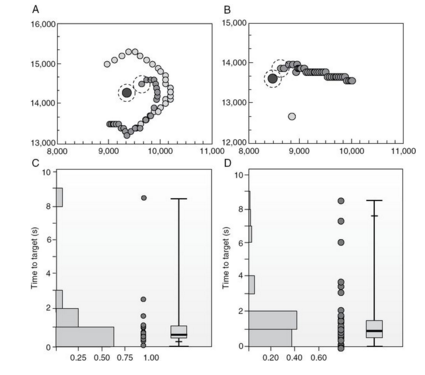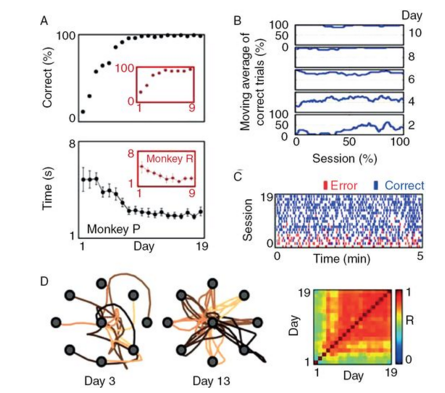Cursor Control
- control of computer cursors using motor neurons
- allow locked-in patients to access menus
- Two types of cursor control:
- 1. Linear control
- monkeys use 7-30 primary motor neurons to move mouse cursor
- uses hand to track continuous target, following the trajectory, then replace with neural control
- hand or neural control had around the same reaction time
- 1. Linear control

Cursor control using invasive BCI
A and B map the actual movement of the cursor with x-y coordinates in 50 ms intervals
C and D are the reaction times via hand and neural control, respectively.
2. Nonlinear Kalman Filter
- two monkeys were given two tasks using a joystick:
- i. "center-out"- move cursor from center to a random target
- ii. "pursuit" - monkeys track continuously moving targets
- 94-240 neurons, recorded via multielectrode array in: primary motor cortex (M1), primary somatosensory cortex (S1), dorsal premotor cortex (PMd), posterior parietal cortex (PP), supplementary motor area (SMA)
- neural data used to train nonlinear version of Kalman filter, known as unscented Kalman filter (UKF)

The UKF allows for better tuning due to its quadratic nature. It also uses position and velocity values from 10 consecutive time steps for AR.
BCI Control Enhancements
Combine Proprioceptive and Visual Feedback
- brain relies on kinesthetic feedback from muscles to guide movement
- when visual and kinesthetic feedback are congruent, the responses are much faster.
Cognitive BCIs
BCIs with higher level cognitive signals
Reaching Movements
- neural activity of parietal reach region (PRR) of cerebral cortex can decode the target location of intended reaching movement
- monkey reach at a flashed location after a brief delay period- Bayesian algorithm
- either normally , or via "brain control"
-
Haar wavelet
-signal over interval represented by coefficients - shows only ~60-68% accuracy, but with LFP stimulation along with both spikes, might have 86%
Enhancing Cognitive BCI
- There's Tskip and Tint, Tskip occurs when the information is not yet reliable and Tint shows up for interval for target.
- target response was predicted using spike counts
- overall performance measured by ITR
- best = 6.5 bps for 8 target, translate to 15 words per minute
Invasive BCIs in Human
Cursor and Robotic Control using a Multielectrode Array Implant
- BrainGate sensor, 100 silicon microelectrodes implanted in arm area of primary motor cortex
- But can motor intention still modulate cortical activity three years after spinal cord injury and absence of hand motion?
- imagined hand motion will activate some neurons!
- can move cursor in the general direction but not exactly accurate
- eventually develops wider scopes such as simulated email, draw using paint program, adjust volume, play video games, etc
Cognitive BCIs in Humans
- recall neural activity from human primary motor cortex can control trajectory of cursors
- however, it's the frontal cortex beyond primary motor cortex that is related to planning and initiating movement direction
- this plan worked in monkeys
- still not been tested in depth yet, but positively thought of as to work.
Long-Term Use of Invasive BCIs
- for the two monkey experiment regarding the center-out reaching task, the 128-electrode array remained in the monkey's brains for 19 days.
- it is proven that the longer the monkeys used the device, the higher the accuracy of the task and the lower the reaction time will be.
- if a decoder is shuffled, then humans can take an adjusting period to get used to the new decoder and achieve the same accurate results.

The diagrams show the difference in accuracy and reaction time between the beginning and the end of the experiment.

Starting from around the 8th day, the number of correct trials have been improved significantly. However, the shuffled recorder remains poor in predicting neuroactivity
Long-Term Use of a Human BCI Implant
- neuro point-and-click experiment for five consecutive days
- based on spikes of motor neurons to determine two-dimensional cursor velocity
- 94.9% accuracy for center-out task and 91.9% accuracy for the random target task
- other interferences were measured such as electrode impedances, neural spike waveforms, and local field potentials to rule out discrepancy
deck
By tsunwong625
deck
- 486



